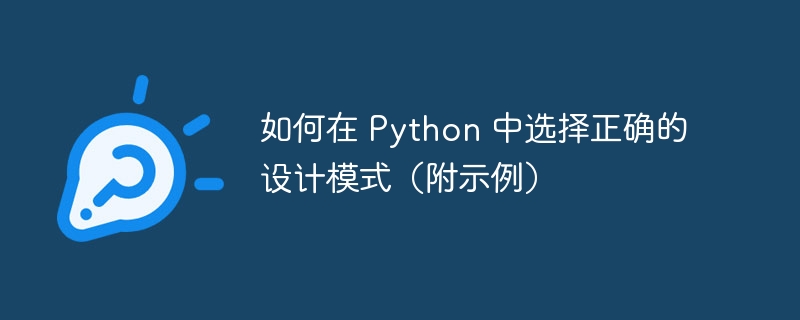如何在 Python 中选择正确的设计模式(附示例)

设计模式是软件开发中常见问题的经过验证的解决方案。它们为解决设计问题提供了可重用的模板,从而提高了代码的可维护性和灵活性。
但是有这么多可用的设计模式,您如何知道针对给定问题在 python 中实现哪一种?在本文中,我们将探讨选择正确设计模式的步骤,并提供每个示例,以帮助您理解和有效应用它们。
1. 理解问题
选择设计模式的第一步是清楚地了解您要解决的问题。问自己以下问题:
预期的行为是什么?
系统有哪些限制?
可能的延伸或变化点有哪些?
2.设计模式分类
设计模式一般分为三类:
创造:关注对象的创建。
结构:关注对象的组成。
行为:关注对象之间的交互。
确定与您的问题匹配的类别有助于缩小相关模式的数量。
3.选择合适的设计模式
了解问题及其类别后,查看该类别中的设计模式以找到最适合您情况的设计模式。考虑以下几点:
灵活性:该模式是否提供必要的灵活性?
复杂性:这不会带来不必要的复杂性吗?
可扩展性:它是否使未来的扩展更容易?
- python 中的设计模式示例 辛格尔顿 什么时候使用它? 当您需要确保某个类只有一个实例并提供对该实例的全局访问点时。
python 示例:
`class singletonmeta(类型):
_instance = {}
def __call__(cls, *args, **kwargs):
if cls not in cls._instance:
cls._instance[cls] = super().__call__(*args, **kwargs)
return cls._instance[cls]
类 logger(metaclass=singletonmeta):
def log(自我, 消息):
print(f"[log]: {消息}")
使用
logger1 = logger()
logger2 = logger()
print(logger1 is logger2) # 输出:true
logger1.log(“运行中的单例模式。”)
`
为什么它有效?
singletonmeta 是一个控制 logger 实例创建的元类。如果实例已存在,则返回该实例,确保只有一个实例。
工厂
什么时候使用它?
当您有一个包含多个子类的父类,并且根据输入数据,您需要返回其中一个子类。
python 示例:
`类形状:
def 绘制(自身):
通过
类圆形(形状):
def 绘制(自身):
print("画一个圆。")
类正方形(形状):
def 绘制(自身):
print("画一个正方形。")
def shape_factory(shape_type):
如果 shape_type == "圆":
返回圆()
elif shape_type == "方形":
返回 square()
其他:
raise valueerror("未知的形状类型。")
使用
shape = shape_factory("圆")
shape.draw() # 输出:画一个圆。
`
为什么它有效?
工厂封装了对象创建逻辑,允许在不暴露底层逻辑的情况下创建实例。
观察
什么时候使用它?
当你有一个对象(主体)需要在状态发生变化时通知多个其他对象(观察者)。
python 示例:
`课程主题:
def init(self):
self._observers = []
def attach(self, observer):
self._observers.append(observer)
def notify(self, message):
for observer in self._observers:
observer.update(message)
类观察者:
def 更新(自我,消息):
通过
类 emailobserver(观察者):
def 更新(自我,消息):
print(f"邮件通知:{message}")
类 smsobserver(观察者):
def 更新(自我,消息):
print(f"短信通知:{message}")
使用
主题=主题()
subject.attach(emailobserver())
subject.attach(smsobserver())
subject.notify("观察者模式已实现。")
`
为什么它有效?
主体维护观察者列表并通知他们变化,从而允许解耦通信。
策略
什么时候使用它?
当您有多种算法来执行一项任务并且您想要动态地交换它们时。
python 示例:
`导入类型
类文本处理器:
def init(自身,格式化程序):
self.formatter = types.methodtype(formatter, self)
def process(self, text):
return self.formatter(text)
def uppercase_formatter(self, text):
return text.upper()
def lowercase_formatter(self, text):
return text.lower()
使用
处理器 = textprocessor(uppercase_formatter)
print(processor.process("hello world")) # 输出:hello world
processor.formatter = types.methodtype(lowercase_formatter, 处理器)
print(processor.process("hello world")) # 输出:hello world
`
为什么它有效?
策略模式允许您通过为格式分配新函数来动态更改对象使用的算法。
装饰器
什么时候使用它?
当您想要动态地向对象添加新功能而不更改其结构时。
python 示例:
`def bold_decorator(func):
def 包装器():
返回“”+ func() +“”
返回包装
def italic_decorator(func):
def 包装器():
返回 "" + func() + ""
返回包装
@bold_decorator
@italic_decorator
def say_hello():
返回“你好”
使用
print(say_hello()) # 输出:你好
`
它为什么有效?
装饰器允许您包装函数以添加功能,例如此处的格式化,而无需修改原始函数。
适应
什么时候使用它?
当您需要使用现有的类但其接口不符合您的需求时。
python 示例:
`europeansocketinterface 类:
定义电压(自身):通过
def live(self): 通过
def 中立(自我):通过
类europeansocket(europeansocketinterface):
定义电压(自身):
返回230
def live(self):
return 1
def neutral(self):
return -1
usasocketinterface 类:
定义电压(自身):通过
def live(self): 通过
def 中立(自我):通过
类适配器(usasocketinterface):
def init(self, european_socket):
self.european_socket = european_socket
def voltage(self):
return 110
def live(self):
return self.european_socket.live()
def neutral(self):
return self.european_socket.neutral()
使用
euro_socket = europeansocket()
适配器 = 适配器(euro_socket)
print(f"电压:{adapter.voltage()}v") # 输出:电压:110v
`
适配器将一个类的接口转换为客户端期望的另一个接口,从而允许不兼容的接口之间兼容。
命令
什么时候使用它?
当您想将请求封装为对象时,允许您使用不同的请求、队列或日志记录来配置客户端。
python 示例:
`类命令:
def 执行(自我):
通过
类 lightoncommand(命令):
def init(self, light):
self.light = 光
def execute(self):
self.light.turn_on()
类 lightoffcommand(命令):
def init(self, light):
self.light = 光
def execute(self):
self.light.turn_off()
类光:
def open_on(自身):
print("灯亮了")
def turn_off(self): print("Light turned OFF")
远程控制类:
def 提交(自我,命令):
命令.execute()
使用
光 = light()
on_command = lightoncommand(灯光)
off_command = lightoffcommand(光)
远程 = remotecontrol()
remote.submit(on_command) # 输出:灯亮
remote.submit(off_command) # 输出:灯关闭
`
为什么它有效?
命令模式将操作转换为对象,允许配置、排队或取消操作。
5. 结论
在 python 中选择正确的设计模式需要清楚地了解要解决的问题和可用的模式。通过对问题进行分类并分析每种模式的优点,您可以选择提供最有效解决方案的一种。
请记住,设计模式是改进代码的工具,而不是需要遵循的严格规则。明智地使用它们来编写干净、可维护且可扩展的 python 代码。
6. 额外资源
书籍:
设计模式:可重用面向对象软件的元素 erich gamma 等人
埃里克·弗里曼 (eric freeman) 和伊丽莎白·罗布森 (elisabeth robson) 的 head first 设计模式。
网站:
重构大师
深入研究设计模式
感谢您的阅读!欢迎在评论中分享您使用 python 设计模式的经验。
以上就是如何在 Python 中选择正确的设计模式(附示例)的详细内容,更多请关注其它相关文章!
